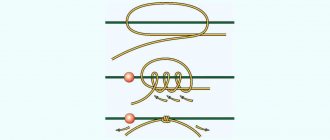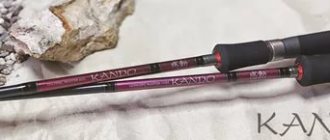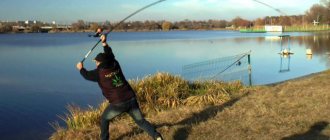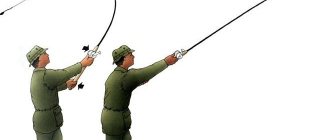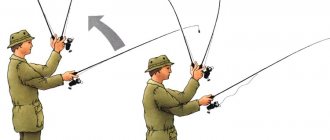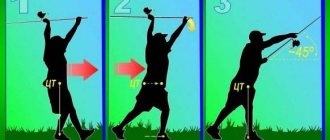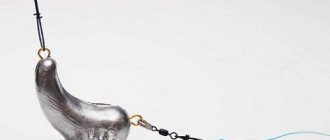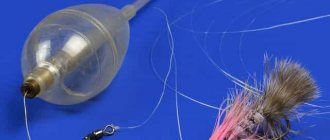With the improvement of gear and the creation of new materials, float fishing is becoming increasingly popular. This type of fishing rod can be a fly rod. It has no rings or coil. Also, the float rod of a more modern version is called a plug rod. Match and Bolognese fishing rods have a spinning reel. Line guides are distributed along the length of the rod.
The first mention of a float fishing rod dates back to the 4th century BC. Such information can be found in ancient Chinese chronicles. It is known that the first float fishing rods had hooks made of bones. The fishing line was replaced by laces obtained from fibers of various animals and plants.
Which fishing rod should you choose first? Overview of main types
The abundance of fishing gear on the market does not make it easy to choose the best solution. First of all, you should take into account the type of fishing rod and its purpose, as well as specific parameters that affect the functionality of the equipment.
There are three main types of fishing rods to choose from, including:
- telescopic fishing rod - unfolds, pushing apart individual elements that are hidden one inside the other. The advantage of this model is, first of all, ease of transportation - we will not have any problems with unfolding and folding,
- segmented fishing rod - consists of several separate parts. Like the telescopic one, it is easy to transport.
- one-piece fishing rod - its main advantage is strength. Compared to the above-mentioned models, it is more resistant to damage. It is devoid of compounds that are known to deteriorate most quickly. Ideal for fishing in salt water. Due to its large size, the fishing rod can cause us some problems during transportation, especially if we travel by public transport.
Fishing with a float rod is accessible to most anglers due to the simplicity of the equipment and the cost of the gear.
The design of the most common fly float fishing rod consists of:
- A rod with a length of 4 to 7 meters (less than 4 meters of fishing rod will be inconvenient due to the casting distance being too short, but they are also used when fishing on ponds and places where casting can be done not very far).
- Line from 0.1 to 0.2 (0.1 is a very thin line and is more suitable for a leash, but 0.15 or 0.2 is quite suitable for the main line).
- The float should be chosen in an oblong shape, although ball- or pear-shaped ones are also chosen by anglers in cases of fishing in the current; it is also very important that the float has a fairly thin antenna for greater sensitivity (less than 3 mm is the best option).
- Lead pellets are sinkers that are attached to the fishing line by clamping with pliers (or teeth), which will load the float so that only the tip is visible from the water.
- Leash - a piece of thinner fishing line after the sinker and in front of the hook, which performs several functions at once:
- when hooking the hook, if you have to break the tackle, only the leash with the hook will break, and the remaining parts of the equipment will remain;
- a line that is less visible in the water will scare the fish less.
- The hook is tied to the leash with a special knot (the size of the hook should be comparable, first of all, to the mouth of the fish being hunted; ideally, the fish should be able to swallow the hook).
When choosing a float fishing rod, you should first take into account the place and method of fishing: on a boat, from the shore or directly in the middle of the reservoir. Finished leashes are stored on a fishing reel. It is easy to purchase at any fishing store.
Hooks
The color and size of hooks for equipping a long-casting fishing rod are presented in different variations. For the presented fishing method, hooks numbered 10-18 are best suited. Their color is selected in accordance with the type of bait. Red varieties are suitable for bloodworms, dark versions are suitable for insects, and white ones are intended for fishing with maggots or bread. If the fish is hungry during a period of turbid water, the color of the hook does not matter much.
A long-casting fishing rod with a float requires the use of a thick wire hook. It is better to take this element 2 numbers more than for regular fishing. This is due to a longer fishing process, when this element of the equipment is subjected to heavy load. To prevent the hook itself or the lips of the fish from breaking, you will need a good strength element of the equipment.
Hooks with a spatula are well suited for the presented method when using fishing line. If you are fishing with a braided thread, you should give preference to a hook with a ring.
The hook must be made of high-quality hardened alloy or non-alloy steel. When pressed, its tip should be elastic and immediately return to its original position.
During fishing, you need to monitor the sharpness of the hook. If roughness appears on it or the sting becomes dull, it is necessary to promptly change the element of the tackle to a new one.
The presented equipment of a fishing rod for long-distance casting will require careful handling during storage. Do not store hooks in a wet state or allow them to come into contact with chemicals. A suitable place for storage is a magnetic box from which they will not fall out without permission.
Tackle
There are 3 main types of float gear:
- fly rod - a rig with a hook is delivered to the fishing spot with a small swing of the rod 1.5-2 rod lengths from the angler;
- a plug rod up to 20 meters long consists of several very long parts that allow you to deliver equipment over a distance of the length of the rod absolutely without any swings (sports tackle);
- A match rod with a sliding rig allows you to cast over long distances and fish in great depths.
We will look at a regular fly rod, which is the simplest tackle for float fishing.
Reel and rod
A spinning reel would be superfluous, but a small drum reel would be just right
Flying rods come with or without a reel.
- A rod with a reel is easier to use and transport.
- In a fishing rod without a reel, the line is attached to the tip of the rod, and the equipment is stored on a special reel separately from the rod. This rod is lighter than a rod with a reel and you can choose a longer option.
Which one to choose? A novice fisherman can choose a rod with a reel, although the option without it is also quite suitable and convenient.
Attention: the reel for the fly float fishing rod is selected to be the simplest - a small drum. No need to buy spinning reels, even the simplest ones!
In the float rig of a fly rod, the reel serves only to store fishing line and winding/winding of fishing line occurs extremely rarely (at the beginning and at the end of fishing). A spinning reel is heavy and simply unnecessary for such fishing.
Characteristics of a sliding float for long casting
The sliding float looks like a ballistic missile combined with an arrow. The arrow-shaped section of the float can reach 200-500 mm in length, and its thickened segment - 20-100 mm . A fixed float can have a lifting capacity of about 3 grams and is equipped with a long keel made of metal or plastic and a thick antenna. Sliding floats have a thinner antenna and usually have a lower carrying capacity.
In equipment with a sliding float, the fishing line must be submerged. For fishing with such a float, a standing or low-current reservoir is suitable. A plug rod with 10-16 rings and light equipment for better casting are used. A reel holder with rings that slide along the handle is a better choice. Reels are suitable for sports ones with a minimum number of bearings, so as not to make the structure heavier. The thickness of the fishing line should be 0.08-0.18 mm , and the length should be 60-80 meters.
A tackle with a sliding float must have stoppers consisting of three elements: a sliding bead, a stopper assembly and a lower stopper pellet. A stopper at the bottom prevents sliding towards the main load. A stop bead fixed in front of the float element prevents the unit from getting into the keel cavity. After the bead, a locking knot with a 2 cm mustache is knitted from the thread.
A sliding float has some advantages:
- Thanks to the attached float, you can attach a small weight to the leash, which will not be noticeable to the fish.
- With it you can fish under the edge of the reeds - a favorite habitat for some species of fish.
- The long casting tackle has a single center of gravity, so the swing will be more accurate and longer.
- The impact of wind and the chance of fishing line flooding are reduced.
- Easy change of load and float.
- Increased sensitivity.
- If there is a large load, the bait will be securely held at the bottom of the reservoir.
It also has a couple of disadvantages:
- The float sinks when fishing "hold".
- In the presence of wind, the casting range and accuracy decrease.
There are three types of sliding floats:
- Having one fastening eye. This model is suitable for fishing with long casting or in calm water. Using the adapter, you can easily change the float element without disassembling the entire equipment.
- Having two fastening ears. This model has high sensitivity and is suitable for fishing in high currents. The lugs have weak fastening elements and can often bend or fall out when hooked.
- Having an axial hole in the center for fishing line. This model is equipped with a voluminous body and can withstand heavy weight. It is easy to assemble and convenient to throw.
The shape of the floats also comes in three types:
- Elongated. It is adapted for long casting in strong winds.
- Oval. It is used at medium distances in moderate winds.
- Round. It is used at short distances in calm conditions.
Equipment
For the most common equipment we will need:
- fishing line the length of the rod, or when using a reel, a longer piece (diameter 0.15-0.20);
- float with a carrying capacity of several grams;
- set with lead pellets;
- a set with rubber casings (sometimes these cambrics are included in a set with lead pellets);
- a small piece of thinner fishing line (0.1-0.13);
- hook 6-10 according to international numbering (on the link you can see the size of such hooks in full size in the image), when choosing, rely on the size of the fish’s mouth, it should fit in the fish’s mouth.
Sequence of rigging a float rod
- A small reel is attached to the rod. If the rod is without a reel, then the fishing line will be attached to the tip of the rod.
- The line wound from the reel is passed through the rings , from the one closest to the reel - to the very last ring at the tip of the rod.
- Float mount. The fishing line is passed into the ring of the float (from top to bottom), and then a small rubber cambric is put on the fishing line. The lower part of the float (keel) is inserted into the cambric. Some floats do not have a ring at the top, then you will need two cambrics to attach the float, bottom and top. One cambric is not enough, as the float can fly out of it.
- Loading the float with lead pellets. By attaching ordinary lead pellets to the fishing line, it is necessary to ensure that only the bright tip of the float appears from the water. This will make the equipment very sensitive to the slightest touch of the fish and will not arouse suspicion in it, since the resistance of the float will be minimal. The last sinker (lead pellet) should be the smallest sinker - the so-called “backup” and it is placed directly in front of the leash.
- Then a 10-20 cm piece of thinner fishing line (leash) is tied to the end of the fishing line .
- And a hook is tied to the end of the fishing line (at a distance of 10-15 cm from the beginning of the leash).
The equipment is ready.
Samodelkins to help
Our fishing Kulibins have long been making long-range homemade floats at home. To make them they use:
- cork or foam for the body;
- plastic or wooden sticks for the antenna and keel;
- lead pellets for loading;
- soft wire for rings;
- fishing varnishes for painting products.
The manufacturing process is simple and can be carried out by an inexperienced DIYer.
- We cut out a spindle-shaped body from foam plastic with a knife or on a lathe.
- Using a drill, we make a hole in it for gluing the antenna.
- We glue the antenna into the body using waterproof glue.
- We make holes in the body for pellets and a mounting ring.
- We glue the pellets and close the holes on top with pieces of foam plastic with glue.
- We twist a loop from copper wire and glue the twist into the body, leaving a ring outside.
- We sand the product and paint it with fishing varnishes.
Homemade float for long casting is ready!
Advice! Before applying varnish to foam, test on a small piece. Some compounds may corrode the material.
Fishing technique with a float rod
general information
You can fish with the above equipment at reservoir depths from half a meter to 2-3 meters (more than that, it will be problematic to make a long cast).
Most fish lead a bottom-dwelling lifestyle (crucian carp, carp, perch, bream, silver bream, ruffe), but there are also riding fish (bleak, verkhovka, rudd).
You must know what kind of fish you are hunting for , or try to fish both on the bottom and near the surface - to determine what kind of fish is found here. Setting the fishing depth is done by moving the float along the line - the closer it is to the hook, the lower the fishing depth is set. If the float is 1 meter from the hook, then the hook will be under water at a distance of 1 meter.
Finding a place and determining the depth
A novice fisherman most likely does not have an echo sounder for fishing from the shore, so he will have to determine the depth in other ways. Analysis of the water surface is very helpful in determining the nature and topography of the bottom.
In any case, your equipment will show you the most accurate depth. Approach the fishing spot - set the hook depth to 0.5 meters by moving the float and cast it to the fishing point. If the float has taken a standard position, it means it is deeper than 0.5 meters. You pull out and increase the depth until you get the float to lie on the surface, this means that the sinkers are on the bottom and the depth you set is too large. Then pull out the rig and reduce the depth by 20 cm. Now your rig is set up to fish along the bottom.
Fishing for crucian carp with a float rod - an overview of gear for catching crucian carp, habits and other subtleties of catching the hardiest Russian fish.
How to choose a float fly rod.
7 simple tips on how to get fish to bite. Exclusive!
Installation of a fishing rod for long casting with a sliding float
Proper collection of float gear for long casting directly contributes to successful fishing. Sinkers are the most important element of fishing rod equipment. For sliding equipment, they are located at a close distance from the leash , and for fixed equipment, closer to the float. The role of sinkers is played by pellets of different shapes. They are selected according to the type of float. The weight of the sinker is related to the diameter of the fishing line.
Sinkers are distributed by weight. Heavier olive-like elements are fixed on top, and smaller pellets below. Heavy weights attract the equipment to the bottom, and small ones stabilize the leader and hooks.
Using carabiners, the leash is attached to the fishing line. The use of protective clips that secure the hook with the bait will prevent the line from tangling when casting.
A cross-lock fastener is attached to the end of a 75 cm long fishing line . A clip is attached above it for protection, then a bead is put on. Next, without clamping, a crimp sleeve is installed and another bead is placed on top. The line goes into the eye of the swivel and is passed through the last bead. An additional swivel is attached to the free end of the fishing line. A leash with an existing hook 60 cm long is attached to the remaining eye on the first swivel.
Nozzles
Don't expect the fish to bite on an empty hook - use bait and lures. In the spring and autumn seasons, it is preferable to use animal baits.
Animal baits that are sold in fishing stores:
- bloodworm;
- maggot (fly larva);
- dung and earthworm.
Plant attachments:
- dough;
- steamed corn;
- steamed pearl barley and other cereals.
If the bite is bad, use “sandwiches” - two different types of baits (maggot and worm, maggot and bloodworm, corn and maggot, etc.)
DIY float
For a real fisherman, there are no hopeless situations, and therefore making a sliding float with your own hands will not be difficult for him. There are two options for constructing such floats.
- Making a float from scratch.
- Modification of finished products.
The types of floats are amazing in their diversity, but we will consider two fundamental designs that you can make with your own hands, and the rest of the models will, to one degree or another, repeat our designs.
Float from scratch
Mounting a float on a fishing line can be done in two ways:
- internal - carried out by threading a working line through the body;
- external - passing the fishing line through the outer rings.
Depending on the chosen design, the choice of antenna and other elements differs slightly. The production of a float with an internal passage of fishing line is carried out in the following sequence:
- We grind out the body and drill a longitudinal hole in it.
- We glue in a long tube so that we have an antenna and a keel of the length we need.
- We carry out the final finishing of the product: sanding and painting.
Finished products are painted with paints, followed by a coating with waterproof varnish, or special fishing varnishes, or alcohol markers.
When making a model with external mount, you need to do it a little differently. Instead of a tube, we glue in a solid antenna, and attach a ring to it, either by gluing it inside or attaching it outside.
In any case, when choosing an adhesive, you need to test it for corrosion of the material, and of course it must be waterproof. If desired, we glue the ring into the body of the float in order to attach it at two points.
Lure
To let the fish know that it is in your fishing spot that it can feast on food and your bait on the hook, you need to feed it.
You can buy bait mixtures in the store, and at the pond, mix them with soil, clay and water and begin feeding by throwing small balls into the water. Or you can prepare it yourself from cereals and many other ingredients:
- pearl barley;
- millet;
- cake;
- dill;
- bran;
- breadcrumbs;
- and other components.
When fishing in the current, mix the bait mixture with clay and sculpt balls from it. Such balls are guaranteed to reach the bottom in the place you need.
Try making balls from commercial Trapper or Sensas bait. You will notice how much more effective they are than regular homemade baits.
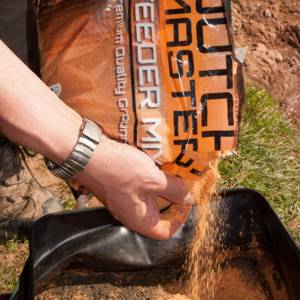
It is also very useful for the bite to add those attachments or baits that you are going to use for bait. This increases the fish's confidence in your bait.
Try not to overfeed the fish and do not throw all the bait into the water at once. Usually, the full effect of bait begins only 15-25 minutes after feeding during the current. But in a body of water with stagnant water, the effect may be delayed. Use aromatic additives for fishing in still water.
We recommend buying bait from the following manufacturers at an affordable price:
- Sensas
- Traper
- Vde
- Pelican
- Dunaev
They have been tested by many anglers.
Features of choosing a float
There is a large selection of sliding floats that have a single attachment point . These floats are suitable for small currents or standing water. The choice of model depends on the behavior and weight of the fish, as well as the fishing depth. The float element with a single attachment point provides a more accurate hookup and makes it easier to spot a bite on the rise. They are more accurate and smooth when casting.
If the current is strong, fishing with a sliding float will be difficult. He will dive, colliding with any debris that the current brings and create a false biting effect.
For fast currents, a fixed float . It is less susceptible to various obstacles and changes in current speed. This float element has two attachment points and does not require recessing the fishing line.
The rod for such fishing has a length reaching 4-8 meters and is equipped with guide rings. The floats are lowered to the level of the yellow stripe. The guide rings must be placed behind the body to ensure smooth movement of the float and prevent the fishing line from clinging to it.
When fishing at different distances, you need to take floats that have a replaceable antenna. You should wind up a smaller antenna as you decrease the fishing distance so that it is not so noticeable to the fish.
Let's sum it up
Float tackle is very common and suitable for catching both peaceful and predatory fish. Most fish willingly bite on animal baits (especially in the demi-season). But predators do not bite on plant baits.
When fishing, first of all try to catch fish along the bottom. Use “sandwiches” from various attachments.
In ponds you can most often catch with a float rod: crucian carp, perch, bleak, rotan, ruff.
On large rivers, the catch is dominated by: roach (roach), perch, bream, crucian carp, ide, silver bream, gobies and other peaceful and predatory fish.
Float selection
Sliding floats are made at the factory or with your own hands; they can be of various types:
- with a longitudinal tube through which the main line is passed;
- with a separate eyelet for fastening at one lower point;
- with a ring in the body of the float and the end of its keel - a sliding mount with two points.
The first type of floats is used mainly on live bait fishing rods, while the remaining types are used for long casts. The longest-range of them are the so-called wagglers - large floats with an attachment at the bottom point and long antennas.



